The finalists for the Norris Trophy were announced and without much surprise, they are Roman Josi, Quinn Hughes, and Cale Makar. It is quite the trio of defencemen who all have some argument to being the winner: Josi was probably the best defenceman in the league after the Christmas break, Makar led the league in points per game by a blue liner, and Hughes was the best defenceman up until Christmas and was still excellent thereafter.
Just my two cents but Hughes should win this. He was a huge reason for Vancouver's turnaround in the regular season and though his best hockey was the first 30 games of the yea, the team controlled 59% of both expected goals and actual goals at 5-on-5 with him on the ice after the Christmas break. Just a superlative season from start to finish.
*
News about Tony DeAngelo's injury:
That he should be good to go for the next round is kind of important given Brett Pesce's current injury status. If there are updates – and those are rare in the playoffs – we'll pass them along.
*
We also got an update on Sam Bennett:
Antony Lundell played very well in Bennett's absence but this team is clearly a lot deeper when they can use Lundell on the third line. Again, if we get any more updates, we'll pass them along.
*
The Dallas Stars have taken 3-2 series lead thanks to a 3-2 win in Game 5 of their matchup against Vegas. Mark Stone gave the Golden Knights an early lead with a deflection on the power play, but Evgenii Dadonov finished off a slick pass from Logan Stankoven to tie things at one apiece. Matt Duchene and Jason Robertson also scored power play goals, and they proved the difference in the matchup.
Wyatt Johnston had a pair of helpers, one on the power play, to push his postseason point production to three goals and three assists. Miro Heiskanen also had a power play assist, totaling two shots, two PIMs, and two hits. He is up to five points in five games.
That pass from Stankoven deserves another mention here. Good grief what a play by the rookie:
William Carrier scored the other goal for Vegas.
Jake Oettinger stopped 25 of 27 shots in the win, including a late-game split-save to preserve Dallas's lead.
Game 6 is on Friday night.
*
A pair of goals from Leon Draisaitl, including one on the power play, helped lift Edmonton to a 4-3 win over Los Angeles, taking their first-round series by a 4-1 margin. Evander Kane opened the scoring on a backhand that goaltender David Rittich probably should have stopped, and Zach Hyman scored his seventh goal of the series late in the second period which held up as the game-winner.
Stuart Skinner stopped 18 of 21 shots in the series-clincher.
Evan Bouchard had a trio of assists (one on the PP) with two shots and three blocks. He had one goal and eight assists in the five games, figuring in on 11 of Edmonton's 22 goals.
Alex Laferriere, Adrian Kempe, and Blake Lizotte replied for the Kings. Rittich ended up allowing four goals on 26 shots.
Edmonton has now advanced to the second round in three straight seasons as they make their bid for the franchise's first Stanley Cup Final appearance since 2006. They will face the winner of the Vancouver-Nashville series.
This is a fascinating summer coming for Los Angeles. The Pierre-Luc Dubois trade has not worked out and they have nearly $21M in cap space, per Cap Friendly. They have Matt Roy as a free agent, and he'll probably be replaced by Brandt Clarke, with no goalies signed and Viktor Arvidsson likely testing the free agent waters elsewhere. They also have Jordan Spence, Quinton Byfield, Carl Grundstrom, Arthur Kaliyev, and Lizotte as restricted free agents. Signing two goalies, and a long-term extension from Byfield, will probably eat 50-60% of the team's available cap space. Short-term contracts for the rest of their RFAs will come close to filling what's left of the cap space. They are short on draft capital, short on cap space, and this team is clearly not in the Colorado-Dallas-Edmonton tier in the West right now. Interesting offseason, indeed.
*
With the fantasy hockey offseason here, my review of the 16 non-playoff teams is underway. We have gone over the seasons of the San Jose Sharks, the Chicago Blackhawks, the Anaheim Ducks, and the Columbus Blue Jackets. Next up is the Montreal Canadiens. Let's look at what went wrong, what went right, and where they go from here. This is all through a fantasy lens, of course.
Data from Natural Stat Trick, Evolving Hockey, HockeyViz, and Frozen Tools with salary cap data from Cap Friendly. Any tracking data is from AllThreeZones unless otherwise noted.
What Went Wrong
For the second season in a row, Montreal was a bottom-5 team by goals against. How they got there is very important to dissect, though.
At 5-on-5, the Canadiens weren't that bad. They were 27th by shots against per minute, but there was a sizable gap between them and 30th-place Columbus (about 2.1 shots per 60 minutes) so they were closer to teams like Pittsburgh, Nashville and Nashville than the bottom of the league. The expected goals against rate was worse but a top-10 save percentage at 5-on-5 also led to them having a goals against rate of 2.5 per 60 minutes, or just behind playoff teams like Vegas (2.42) and the New York Rangers (2.48). The defensive issues were bad, but not abysmal, and good goaltending (we'll get back to that) helped a lot.
The penalty kill was a different matter. The league average for power play opportunities given per game was 3.02 and the Canadiens had the third-highest rate at 3.37 (Anaheim was way ahead of everyone else at 4.02). Montreal's penalty kill gave up the sixth-most shots per minute and seventh-most goals per minute. Add that to their penalty-taking penchant and they allowed 65 power play goals overall, the third-most in the league (though, again, Anaheim was way in front at 91). This is what it looked like on the ice; dark-brown areas are where the opposing power play is taking more shots than the league average, and the darker the colour, the more shots allowed. It isn't good:
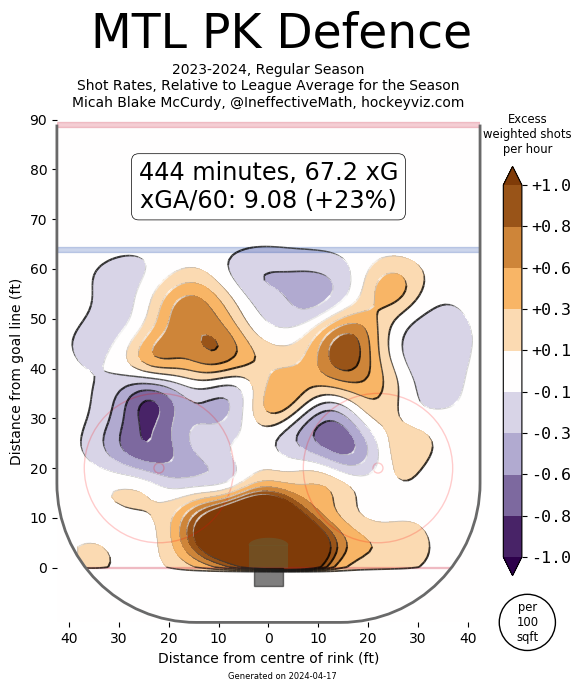
This was one season after giving up the seventh-most power play opportunities and third-most power play goals against, too. As good as Montreal's goaltending largely was, there is no quicker way to deflate a goalie's fantasy value than their team being undisciplined with a bad penalty kill, so, on top of improvements elsewhere, the fantasy value of Sam Montembeault will not truly ascend until this team either stops taking so many penalties (like Nashville in recent seasons) or becomes much more proficient on the penalty kill (like Florida in recent seasons).
The power play was also a problem for goals against. In 2022-23, the Habs gave up just three short-handed goals against, which was tied for the lowest total in the league. In 2023-24, they gave up 12 short-handed goals against, which was tied for the highest total in the league. We will get to the power play a little later, but Montembeault gave up eight goals with his team on the power play this season, finishing with the second-highest goals against rate on the power play among regular starters this season. Cutting that number in half would boost his overall save percentage from .903 to .906 and lower his goals against average from 3.14 to 3.04. Just marginal improvements in how they manage the puck on the power play would be impactful for Montembeault.
Montreal's lack of 5-on-5 scoring remains a problem. They finished 25th by goals-for rate, a drop from their 22nd -place finish in 2022-23. After moving Juraj Slafkovsky to the top line in early December, the team was 19th by goals-for per 60 minutes at 5-on-5, and ahead of teams like Florida and Carolina, so that's a good sign. What isn't a good sign is that Alex Newhook was their only regular forward to post at more than 1.9 points/60 at 5-on-5, which gave them precisely one forward higher than the 67th percentile of 5-on-5 point production in the league. The NHL is a power play/penalty kill league now, but with the Canadiens having a heavily-used top PP unit, the rest of the lineup needs to produce at even strength to have fantasy value, and that's tenuous right now.
It was an awful year for Josh Anderson, too. His nine goals in 78 games were a steep drop from his prior three seasons with Montreal where he scored 23.4 goals every 78 games. His 20 points were also a steep drop from the 36 points/78 games from those three seasons. Beyond his individual performance, the team created far fewer expected goals with him on the ice at 5-on-5, too. Here is the team's shot map with Anderson on the ice in 2022-23:
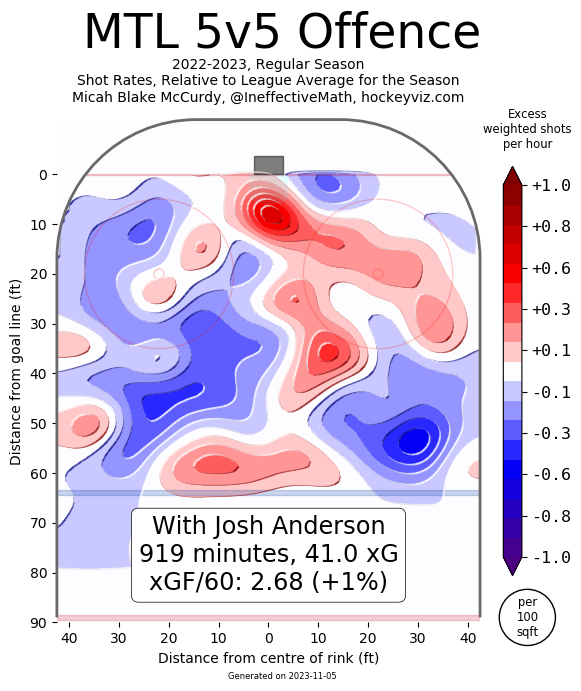
And this is what it looked like this season:
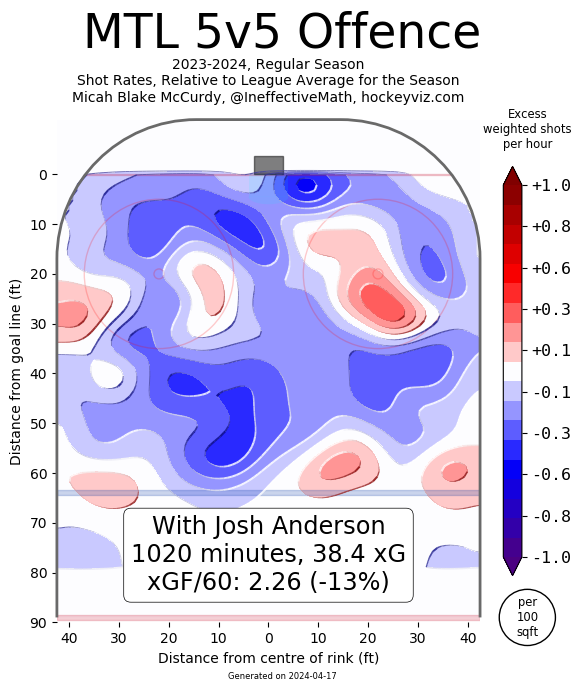
If he is on the ice at 5-on-5, and the team can't generate from the net-front/low-slot area, then it's a huge problem for him and his line mates, scoring-wise.
The hits and penalty minutes helped float Anderson's value in multi-cat leagues, and shooting 6.4% against a three-year average of 13% says there was some bad luck, but he also saw his role diminished as the season wore on. The top line is set, Newhook will be part of the second line, and a healthy Kirby Dach should be as well. Anderson may well be a 14-minute player next year, and that brings into question just how far his goal production can rebound, even if he shoots 11-12%.
Brendan Gallagher scored 16 goals and tallied 31 points in 77 games, which were both four-year highs. The problem is he was injured often the prior three seasons and those campaigns saw him average 17.4 goals and 36.7 points every 77 games, so it was a per-game decline. Gallagher is now sitting at 0.7 goals per 60 minutes at 5-on-5 over the last three seasons, which is a cataclysmic drop from the 1.48 goals/60 he scored from 2018-2021. He saw a career-low 13:47 per game and, like Anderson, he may be stuck as a third-line/second power play forward next season. He turns 32 years old next week and is over 800 total NHL games, playing a very hard style. This may be the end of the road for even modest fantasy value from Gallagher.
Lastly, the blue line is a persistent question mark. We will get to Mike Matheson's fantasy season a bit later, but it was actually David Savard who led their defencemen by points/60 at 5-on-5 in 2023-24. He had a great rate – comparable to names like Noah Dobson and Kris Letang – but the rest of the team did not as he was the only blue liner inside the 67th percentile by points rate, which is the cutoff for a top-pair rate. The lack of scoring from the forwards is a big part of it, but the other part is being pinned in their own end often. Montreal's defencemen averaged a failed zone exit 28.1% of the time against a league average of 26.1%. They had three options failing to exit the zone at least 31% of the time, with the worst offender being Arber Xhekaj. Here were his league-wide comparables by this measure:

The next highest rate belonged to Justin Barron, and these were the immediate comparable players league-wide:

It isn't to say that failing to exit the zone automatically means bad fantasy value; good-to-great options like Noah Dobson, Zach Werenski, and John Carlson were all at 32% or higher. But those are the exceptions that prove the rule, and the more time Montreal spends in their zone, the less time they have offensively, and it puts more pressure on their goalies.
All told, there wasn't a lot tremendously wrong with the season. Injuries kept Dach out of the lineup nearly the entire year and Newhook for nearly one-third of the campaign. Add that to Sean Monahan being traded with 33 games left, and what could have been their second line played 106 of a possible 246 games. The defence didn't really take a leap forward, but we'll get to that later in these Ramblings. Fewer penalties and/or a much better penalty kill would go a long way to helping Montembeault's fantasy value take a step forward, and that'll be something to watch in 2024-25.
What Went Right
As the resident Montreal fan watching this rebuild, and knowing a playoff was not in the cards, there was a list of things fans wanted from this season:
- Slafkovský takes a step forward in his development after a tough rookie year.
- Cole Caufield cements himself in the tier below the top goal scorers in the league.
- Nick Suzuki finally puts all his offensive and defensive skills together.
- Newhook and Dach have good years that validate their respective trades.
- At least a couple of the young defencemen like Kaiden Guhle, Justin Barron, Arber Xhekaj, and Jordan Harris take a big step towards being reliable NHL defencemen.
- One of Sam Montembeault or Cayden Primeau grabs hold of the starting job.
A lot of that actually happened.
Let's start with the top line and Suzuki. His 33 goals and 44 assists were both personal bests, and his 31 power play points were by far a career-high (he had 20 in 2021-22). Skating over 21 minutes a game helps a lot because his shot and hit rates per minute were in the 28th percentile and 25th percentile, respectively. It is back-to-back seasons averaging over 21 minutes a game, though, and with some shaky third and fourth lines, he could see that again next season.
Offensively, Suzuki's effect on his teammates was felt by his transition and playmaking. The league average percentage of zone entries carried in by a forward was 52.1%, and the percentage of entries passed in by a forward was 13.6%. Suzuki was at 60.7% and 22.5%, respectively. Here are the forwards (min. 250 tracked minutes) that averaged at least 20 entries per 60 minutes, a carry-in rate of at least 60%, a pass-in rate of at least 20%, and whose carried entries resulted in a scoring chance at least 30% of the time:

That the top line was so good at 5-on-5 after their assembly in December is a big part of the scoring chance production, but this is now two years in a row with a carry percentage over 60% and a pass percentage considerably higher than the league average. There are peripheral concerns for multi-cat formats, but given all the ice time and the progression of Suzuki and his wingers, he could very well be a 30-goal, 80-point forward from now on. In fantasy terms, it should be similar to what Mark Scheifele has done for the last 7-8 years.
At the start of the season, if you told me Caufield would play all 82 games, average nearly 19:30 per night, and manage over 3.8 shots per appearance, I would have said that 35 goals was the minimum to reasonably expect. In that sense, finishing with 28 goals is a letdown, but there was a recent article from Arpon Basu at The Athletic outlining why it may take a couple years for Caufield's shoulder to return to normal from his surgery. In that context, the shooting percentage drop makes sense, and that he still scored 28 goals and generated all those shots portends 40-goal, 80-point seasons sooner rather than later.
Of course, the big one is Slafkovský. There was a lot of consternation around his first overall selection (including from me), but he took a big step forward with 20 goals, 30 assists, 14 power play points, 55 penalty minutes, and both 152 shots and hits. That is a stellar multi-cat season in and of itself, and he didn't turn 20 years old until the end of March.
Here are the improvements Slafkovský made:
- Even strength goals/60 up 62%.
- Even strength assists/60 up 47%.
- Even strength shot attempts/60 up 10%.
- Even strength individual expected goals/60 up 67%.
- Carry-ins on zone entries from 34.6% to 53.6%.
- Passing for zone entries 13.8% of the time against a team average of 11.8% after not showing up in this stat at all as a rookie.
- Expected goals-for impact sky-rocketed from the 9th percentile to the 87th percentile.
There were significant improvements in several key areas and while some of that can be chalked up to playing three-quarters of his season at 5-on-5 with Caufield and Suzuki, if he was playing poorly, he wouldn't have stayed on that line for four months. That he received so much top PP time is great for his fantasy value and once he starts shooting more, he'll really unlock that next level of across-the-board fantasy upside.
The power play also helped Matheson to a great fantasy season. That he averaged 25:33 per night greatly helped him to his 11-goal, 62-point, 187-shot, and 186-block season, but his 28 power play points were more than he had produced in his entire 465-game career (25) until this season. We will get into why his fantasy value may have peaked in a second, but fantasy managers who believed in his potential (and potential role) were richly rewarded.
Newhook had a good year with 15 goals (a career-high) and 34 points (also a career-high) in just 55 games. There are concerns, though, as his shot rate was 33rd percentile, he doesn't hit much, and the return of Dach could push Newhook off the top power play unit. He also shot over 20% at 5-on-5 and had more secondary assists than primary ones. If those things regress, and he doesn't shoot or hit much, and he loses his top PP role, well, he may not improve much on 2023-24's production even with 80 games played.
Then there is Montembeault. His .903 save percentage isn't elite, but it's league average, and doing that on a team that was bad defensively at all strengths, and took a lot of penalties, is a great sign. He now has three years with Montreal and of 33 goalies with at least 5000 even strength minutes played in that span, he is ninth by goals saved above expected per 60 minutes. He is in a tier below the elite like Connor Hellebuyck, Ilya Sorokin, and Igor Shesterkin, but still find himself among some top netminders:

Cayden Primeau also had a good season, so he's not to be discounted too heavily, but it was his first season of any sort of sample and this was Montembeault's third season with at least 30 starts. If Montreal's penalty kill improves, along with their 5-on-5 scoring, Montembeault could easily be a top-20 fantasy goalie. Those are some big 'ifs' though.
Where They Go From Here
This is a team at kind of a crossroads. The three top young forwards are all ascending and Montembeault is another good season away from truly cementing himself as an upper-half NHL starter. Top prospect defenceman Lane Hutson signed at the end of the season and had a good showing in a pair of games, while David Reinbacher had five points in 11 games after making his way to the AHL. Those two should be the twin pillars of Montreal's blue line for years to come, and even Logan Mailloux got a game in at the end of the season. The issue is six defencemen are signed for 2024-25, and they are certainly going to re-sign Xhekaj and Barron as RFAs. They can make room by trading Savard, or putting someone on waivers, so Hutson could be in the NHL all year. Despite that, Matheson likely holds the top PP role out of the gate, and until the team develops more offence in its middle-6 forward mix, point production may be tough for the young blue liners.
Assuming Xhekaj and Barron sign low-dollar, short-term deals, the Canadiens probably have around $15M in cap space to spend. They are a year away from extending Slafkovský, but both Suzuki and Caufield have already locked in long-term deals, Montembeault's new contract starts in 2024-25 and is for three years, and Dach is signed for two more. They have the cap space to go after a big free agent like Sam Reinhart or Jake Guentzel, but with $12M due each year to Anderson and Gallagher for three more seasons, they may not want to add more veteran money (and probably shouldn't).
The team has a shot at Macklin Celebrini in the Draft Lottery. Even if they don't land him – and it's very unlikely – they will still get a high pick in a draft year with a lot of good prospects in the top-10. Perhaps they weaponize their cap space by doing what they've done in recent seasons and use their extra first-round pick (from the Monahan trade) to go get a young RFA.
As long as the top line stays healthy, they should all be as productive, if not more so, in 2024-25 than 2023-24. A better penalty kill would help Montembeault's fantasy value greatly, but that improvement is far from a certainty. There are still several unproven defencemen under the age of 25 so while a healthy Dach and Newhook, and maybe adding a genuine top-6 forward via trade or free agency, would boost even strength scoring, the team defence could still be shaky enough to make Montembeault unreliable for fantasy, even if he has a solid overall season.
Despite the team's desire to push for a playoff spot, it seems more likely that they're on the outside looking in. That doesn't mean there won't be good fantasy options, though, as all of Caufield, Suzuki, and Slafkovský are valuable (to varying levels in different formats). If Matheson holds onto the top PP role all year, he is a 10-goal, 50-point threat once again, and Montembeault could be even better if the team's discipline improves. They are probably a year away from truly pushing into the playoffs, but the number of viable fantasy options is starting to grow, and that's really fun.
One Comment
Leave A Comment
You must be logged in to post a comment.



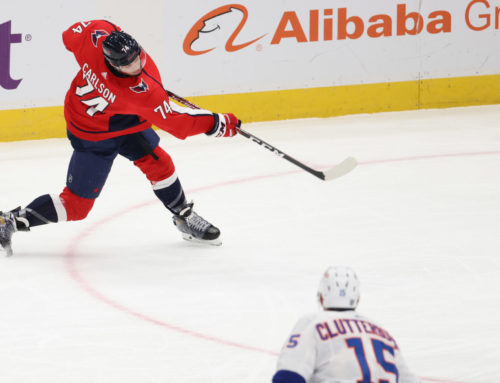
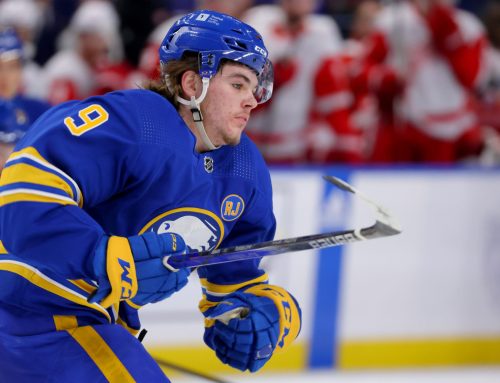
 MTL
MTL
 PIT
PIT FLA
FLA S.J
S.J CGY
CGY MIN
MIN PHI
PHI BOS
BOS

Wait until Sydney Crosby gets there! You read it here first.